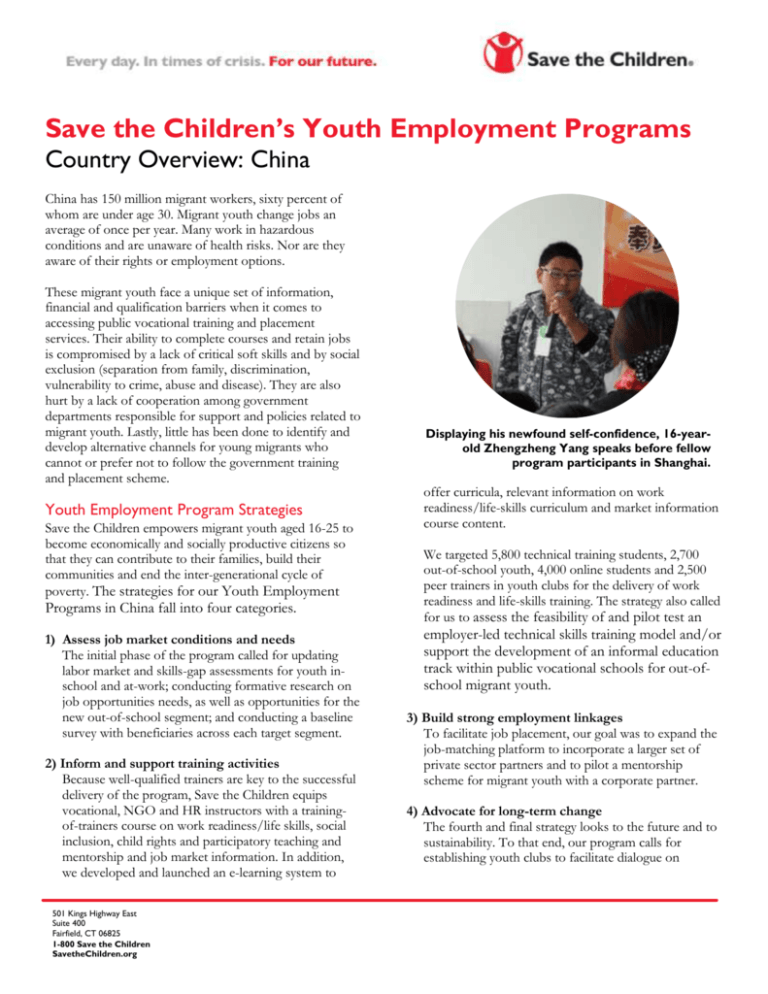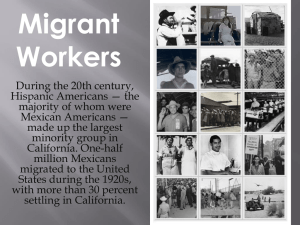Country Overview: China
advertisement

Save the Children’s Youth Employment Programs Country Overview: China China has 150 million migrant workers, sixty percent of whom are under age 30. Migrant youth change jobs an average of once per year. Many work in hazardous conditions and are unaware of health risks. Nor are they aware of their rights or employment options. These migrant youth face a unique set of information, financial and qualification barriers when it comes to accessing public vocational training and placement services. Their ability to complete courses and retain jobs is compromised by a lack of critical soft skills and by social exclusion (separation from family, discrimination, vulnerability to crime, abuse and disease). They are also hurt by a lack of cooperation among government departments responsible for support and policies related to migrant youth. Lastly, little has been done to identify and develop alternative channels for young migrants who cannot or prefer not to follow the government training and placement scheme. Youth Employment Program Strategies Save the Children empowers migrant youth aged 16-25 to become economically and socially productive citizens so that they can contribute to their families, build their communities and end the inter-generational cycle of poverty. The strategies for our Youth Employment Programs in China fall into four categories. 1) Assess job market conditions and needs The initial phase of the program called for updating labor market and skills-gap assessments for youth inschool and at-work; conducting formative research on job opportunities needs, as well as opportunities for the new out-of-school segment; and conducting a baseline survey with beneficiaries across each target segment. 2) Inform and support training activities Because well-qualified trainers are key to the successful delivery of the program, Save the Children equips vocational, NGO and HR instructors with a trainingof-trainers course on work readiness/life skills, social inclusion, child rights and participatory teaching and mentorship and job market information. In addition, we developed and launched an e-learning system to 501 Kings Highway East Suite 400 Fairfield, CT 06825 1-800 Save the Children SavetheChildren.org Displaying his newfound self-confidence, 16-yearold Zhengzheng Yang speaks before fellow program participants in Shanghai. offer curricula, relevant information on work readiness/life-skills curriculum and market information course content. We targeted 5,800 technical training students, 2,700 out-of-school youth, 4,000 online students and 2,500 peer trainers in youth clubs for the delivery of work readiness and life-skills training. The strategy also called for us to assess the feasibility of and pilot test an employer-led technical skills training model and/or support the development of an informal education track within public vocational schools for out-ofschool migrant youth. 3) Build strong employment linkages To facilitate job placement, our goal was to expand the job-matching platform to incorporate a larger set of private sector partners and to pilot a mentorship scheme for migrant youth with a corporate partner. 4) Advocate for long-term change The fourth and final strategy looks to the future and to sustainability. To that end, our program calls for establishing youth clubs to facilitate dialogue on migrant youth working rights and responsibilities, skills acquisition and placement experiences and policy and practice recommendations. Establishing a multistakeholder network with government, private sector and civil society representatives will drive forward policies and practices that address barriers – in schools, communities, and workplaces – that make it difficult for migrant youth to access competitive skills training and retain jobs. Zhengzheng Yang’s Story Program Locations Shanghai, Beijing, Guangzhou Target Youth Participants Migrant youth from 16 to 25 years old Primary Partners National Social Science Academy Shanghai Education Science Academy Four NGOs based in Beijing, Shanghai and Guangzhou Accomplishments to Date To fuel our learning and ensure the program is in step with market needs, a labor market assessment was conducted in Beijing, Shanghai and Guangzhou and reports of findings were produced. In addition, a baseline survey was conducted in the same three cities and a baseline report was completed. By the end of December 2014, Save the Children had empowered more than 2,500 migrant youth and more than 800 out-of-school youth with soft skills and almost 1,000 youth benefited from peer education. During the same period, Save the Children reached almost 2,000 migrant youth (40 percent of whom were girls) by promoting an elearning course online. Plans for the Future Moving forward, we hope to further strengthen the program and the strategies that have worked so well to date. Our goals include promoting the life-skills training package in response to the needs of the most vulnerable groups. We will also promote career-planning tools and methodology based on labor market information and analysis, and we will enhance the use of technology in project management. 501 Kings Highway East Suite 400 Fairfield, CT 06825 1-800 Save the Children SavetheChildren.org Zhengzheng Yang, 16, is a migrant youth who participated in a program training camp. Pictured above talking with one of the trainers, the teenager feels he gained a great deal from soft-skills training, measurably improving his self-confidence. “I was delighted to start studying in Shanghai and felt I would be the best one in the class,” he recalls. “But I was wrong. I felt inferior to some of my classmates who showed a sense of superiority because they were local. But I was eager to know how to set my life goals and realize them. “When I was informed the program would be implemented in our school, I was excited and signed up eagerly. After a strict verification, I became a program student. One of the lecturers asked us to recall successful experiences to identify core competencies. It helped me to find my strengths, which are getting along with counterparts, being brave about shouldering responsibilities and taking leadership.” Ms. Zhao, a chief trainer, gave Zhengzheng Yang high praise based on his performance in training. “He was absorbed in the training and good at mobilizing other members of his team to fulfill the common target. He has great potential to be a leader in his future career,” she says. Leadership and communication skills were integrated into the training so that everyone was encouraged to communicate with each other and to learn about advantages and strengths from peers. “The strongest impression the program made on me is a spirit of unity, endeavor, cooperation and accomplishment,” Zhengzheng Yang says. “The experiential learning adopted in training is so much different from the traditional way of teaching in class. I like this way of learning which allows us to experience knowledge and skills ourselves. I hope we can be provided with more opportunities to learn like this.” For additional information about Save the Children’s Youth Employment Program, please contact: Kevin McAndrew Associate Director Corporate Partnerships Save the Children USA Office: 1.475.999.3161 Mobile: 1.413-636-2154 kmcandrew@savechildren.org 501 Kings Highway East Suite 400 Fairfield, CT 06825 1-800 Save the Children SavetheChildren.org Patricia E. Langan Program Director, Skills to Succeed Hunger and Livelihoods Department Save the Children USA Office: 1.202.640.6839 Mobile: 1.202.294.2644 plangan@savechildren.org





